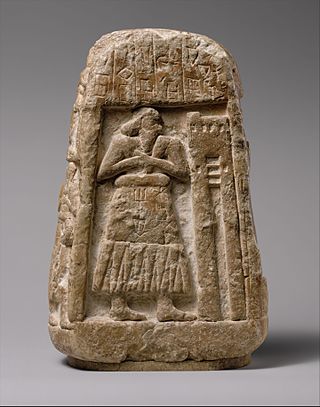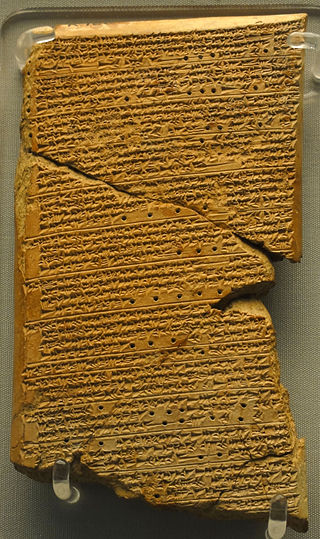
Sin or Suen (Akkadian: 𒀭𒂗𒍪, dEN.ZU) also known as Nanna (Sumerian: 𒀭𒋀𒆠DŠEŠ.KI, DNANNA) was the Mesopotamian god representing the moon. While these two names originate in two different languages, respectively Akkadian and Sumerian, they were already used interchangeably to refer to one deity in the Early Dynastic period. They were sometimes combined into the double name Nanna-Suen. A third well attested name is Dilimbabbar (𒀭𒀸𒁽𒌓). Additionally, the moon god could be represented by logograms reflecting his lunar character, such as d30 (𒀭𒌍), referring to days in the lunar month or dU4.SAKAR (𒀭𒌓𒊬), derived from a term referring to the crescent. In addition to his astral role, Sin was also closely associated with cattle herding. Furthermore, there is some evidence that he could serve as a judge of the dead in the underworld. A distinct tradition in which he was regarded either as a god of equal status as the usual heads of the Mesopotamian pantheon, Enlil and Anu, or as a king of the gods in his own right, is also attested, though it only had limited recognition. In Mesopotamian art, his symbol was the crescent. When depicted anthropomorphically, he typically either wore headwear decorated with it or held a staff topped with it, though on kudurru the crescent alone served as a representation of him. He was also associated with boats.

Shamash was the ancient Mesopotamian sun god, earlier known as Utu. He was believed to see everything that happened in the world every day, and was therefore responsible for justice and protection of travelers. As a divine judge, he could be associated with the underworld. Additionally, he could serve as the god of divination, typically alongside the weather god Adad. While he was universally regarded as one of the primary gods, he was particularly venerated in Sippar and Larsa.The moon god Nanna (Sin) and his wife Ningal were regarded as his parents, while his twin sister was Inanna (Ishtar). Occasionally other goddesses, such as Manzat and Pinikir, could be regarded as his sisters too. The dawn goddess Aya (Sherida) was his wife, and multiple texts describe their daily reunions taking place on a mountain where the sun was believed to set. Among their children were Kittum, the personification of truth, dream deities such as Mamu, as well as the god Ishum. Utu's name could be used to write the names of many foreign solar deities logographically. The connection between him and the Hurrian solar god Shimige is particularly well attested, and the latter could be associated with Aya as well.
Antu or Antum was a Mesopotamian goddess regarded as the feminine counterpart and spouse of the sky god, Anu. She was sometimes identified with the earth rather than the sky, though such references are not common. While already attested in the third millennium BCE, she was only a minor goddess, and only came to be worshiped commonly in Uruk in the Achaemenid and Seleucid periods due to religious reforms which elevated her and Anu to the position of tutelary deities of the city. At some point Antu was also incorporated into Hurrian religion, in which she was understood as a primeval deity. In the so-called "Standard Babylonian" edition of the Epic of Gilgamesh Antu is addressed as the mother of Ishtar, but this tradition was not commonly adhered to.

Ninsun was a Mesopotamian goddess. She is best known as the mother of the hero Gilgamesh and wife of deified legendary king Lugalbanda, and appears in this role in most versions of the Epic of Gilgamesh. She was associated with Uruk, where she lives in this composition, but she was also worshiped in other cities of ancient Mesopotamia, such as Nippur and Ur, and her main cult center was the settlement KI.KALki.
Ninlil was a Mesopotamian goddess regarded as the wife of Enlil. She shared many of his functions, especially the responsibility for declaring destinies, and like him was regarded as a senior deity and head of the pantheon. She is also well attested as the mother of his children, such as the underworld god Nergal, the moon god Nanna or the warrior god Ninurta. She was chiefly worshiped in Nippur and nearby Tummal alongside Enlil, and multiple temples and shrines dedicated to her are attested from these cities. In the first millennium BCE she was also introduced to Ḫursaĝkalamma near Kish, where she was worshiped alongside the goddess Bizilla, who was likely her sukkal.

Damgalnuna, also known as Damkina, was a Mesopotamian goddess regarded as the wife of the god Enki. Her character is poorly defined in known sources, though it is known that like her husband she was associated with ritual purification and that she was believed to intercede with him on behalf of supplicants. Among the deities regarded as their children were Nanshe and Asalluhi. While the myth Enki and Ninhursag treats her as interchangeable with the goddess mentioned in its title, they were usually separate from each other. The cities of Eridu and Malgium were regarded as Damgalnuna's cult center. She was also worshiped in other settlements, such as Nippur, Sippar and Kalhu, and possibly as early as in the third millennium BCE was incorporated into the Hurrian pantheon. She appears in a number of myths, including the Enūma Eliš, though only a single composition, Damkina's Bond, is focused on her.

Nisaba was the Mesopotamian goddess of writing and grain. She is one of the oldest Sumerian deities attested in writing, and remained prominent through many periods of Mesopotamian history. She was commonly worshiped by scribes, and numerous Sumerian texts end with the doxology "praise to Nisaba" as a result. She declined after the Old Babylonian period due to the rise of the new scribe god, Nabu, though she did not fully vanish from Mesopotamian religion and attestations from as late as the neo-Babylonian period are known.

Nanaya was a Mesopotamian goddess of love, closely associated with Inanna.

Ninshubur, also spelled Ninšubura, was a Mesopotamian goddess whose primary role was that of the sukkal of the goddess Inanna. While it is agreed that in this context Ninshubur was regarded as female, in other cases the deity was considered male, possibly due to syncretism with other divine messengers, such as Ilabrat. No certain information about her genealogy is present in any known sources, and she was typically regarded as unmarried. As a sukkal, she functioned both as a messenger deity and as an intercessor between other members of the pantheon and human petitioners.
Aya was a Mesopotamian goddess associated with dawn. Multiple variant names were attributed to her in god lists. She was regarded as the wife of Shamash, the sun god. She was worshiped alongside her husband in Sippar. Multiple royal inscriptions pertaining to this city mention her. She was also associated with the Nadītu community inhabiting it. She is less well attested in the other cult center of Shamash, Larsa, though she was venerated there as well. Additional attestations are available from Uruk, Mari and Assur. Aya was also incorporated into Hurrian religion, and in this context she appears as the wife of Shamash's counterpart Šimige.
Gatumdug was a Mesopotamian goddess regarded as the tutelary deity of Lagash and closely associated with its kings. She was initially worshiped only in this city and in NINA, but during the reign of Gudea a temple was built for her in Girsu. She appears in a number of literary compositions, including the hymn inscribed on the Gudea cylinders and Lament for Sumer and Ur.

Shara was a Mesopotamian god associated with the city of Umma and other nearby settlements. He was chiefly regarded as the tutelary deity of this area, responsible for agriculture, animal husbandry and irrigation, but he could also be characterized as a divine warrior. In the third millennium BCE his wife was Ninura, associated with the same area, but later, in the Old Babylonian period, her cult faded into obscurity and Shara was instead associated with Usaḫara or Kumulmul. An association between him and Inanna is well attested. In Umma, he was regarded as the son of Inanna of Zabalam and an unknown father, while in the myth Inanna's Descent to the Underworld he is one of the servants mourning her temporary death. He also appears in the myth of Anzû, in which he is one of the three gods who refuse to fight the eponymous monster.
Ninegal or Belat Ekalli (Belet-ekalli) was a Mesopotamian goddess associated with palaces. Both her Sumerian and Akkadian name mean "lady of the palace."

Ninisina was a Mesopotamian goddess who served as the tutelary deity of the city of Isin. She was considered a healing deity. She was believed to be skilled in the medical arts, and could be described as a divine physician or midwife. As an extension of her medical role, she was also believed to be capable of expelling various demons. Her symbols included dogs, commonly associated with healing goddesses in Mesopotamia, as well as tools and garments associated with practitioners of medicine.

Ninsianna was a Mesopotamian deity considered to be the personification of Venus. This theonym also served as the name of the planet in astronomical texts until the end of the Old Babylonian period. There is evidence that Ninsianna's gender varied between locations, and both feminine and masculine forms of this deity were worshiped. Due to their shared connection to Venus, Ninsianna was associated with Inanna. Furthermore, the deity Kabta appears alongside Ninsianna in many texts, but the character of the relation between them remains uncertain.

Annunitum or Anunītu was a Mesopotamian goddess of war. While initially she functioned as an epithet of Ishtar, she started to develop into a separate deity in the final years of the Sargonic period and through the Ur III period.
Mamu was a Mesopotamian goddess associated with dreams. She was regarded as the daughter of the sun god Utu and could herself be called the "Utu of dreams". References to male Mamu are also known, though it has been proposed that they only represent a late change of gender attested for a number of other originally female deities as well.
Kusu was a Mesopotamian goddess associated with purification and with grain. It is not certain which aspect of her character was originally primary, and which developed secondarily. She was considered to be a member of the court of Enlil, and in a number of text appears with other deities connected to him, such as Nuska. She could also be associated with other deities responsible for exorcisms, such as Ningirima. Multiple sanctuaries dedicated to her existed in Nippur, though she was also worshiped in other cities, for example Lagash and Assur. In the Seleucid period, she was additionally introduced to the local pantheon of Uruk.

Inanna of Zabalam was a hypostasis of the Mesopotamian goddess Inanna associated with the city of Zabalam. It has been proposed that she was initially a separate deity, perhaps known under the name Nin-UM, who came to be absorbed by the goddess of Uruk at some point in the prehistory of Mesopotamia and lost her unknown original character in the process, though in certain contexts she nonetheless could still be treated as distinct. She was regarded as the mother of Shara, the god of Umma, a city located near Zabalam.
Ninura was a Mesopotamian goddess associated with the state of Umma. The god Shara, worshiped in the same area, was regarded as her husband. She is only attested in sources from the third millennium BCE. Her cult started to decline in the Ur III period, and she is no longer attested in Old Babylonian texts. Other goddesses replaced her in both of her roles, with Inanna of Zabalam becoming the goddess of Umma, and Usaḫara or Kumulmul taking her place as Shara's spouse.












